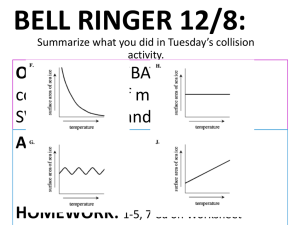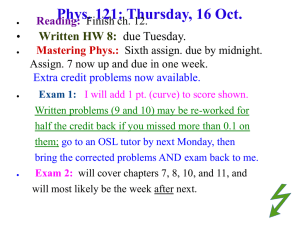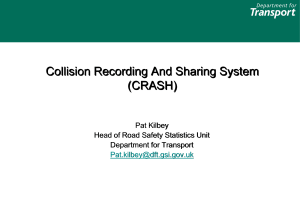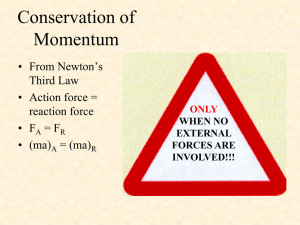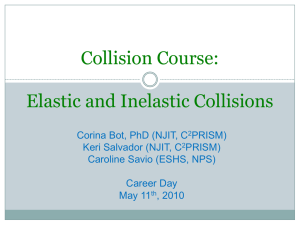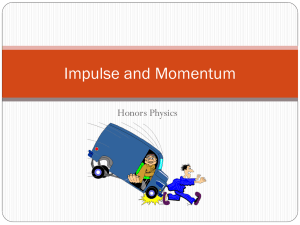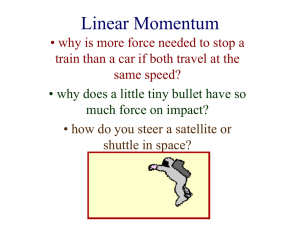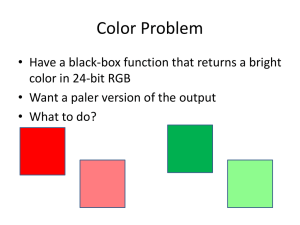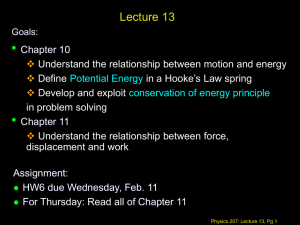Collisions in 2 Dimensions
advertisement
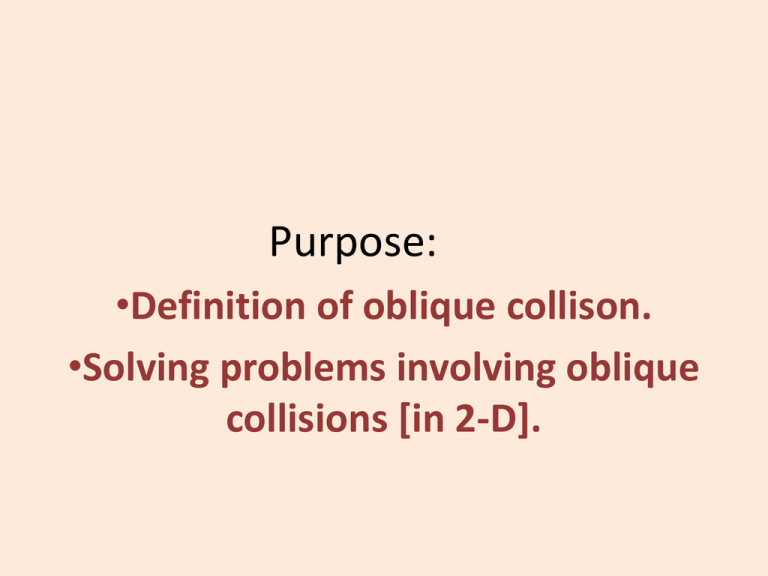
Purpose: •Definition of oblique collison. •Solving problems involving oblique collisions [in 2-D]. Review of Momentum • We have learned that moving objects possess momentum and the momentum can be _______________, calculated by multiplying their mass by their velocity. • When moving objects collide or ________ each other, hit they exert equal and opposite ________________ on forces one another. • Since the forces they exert happen for equal periods of time, they also exert equal and opposite impulses. The change impulse is the transfer or ___________ of momentum from one object to the other and it is always conserved. • The law of conservation states, the total momentum before the collision is equal to the total momentum after the collision. Different Collisions in 2 Dimensions • When objects collide there are three possible types of collisions. • An perfectly elastic collision typically involves objects hitting and moving apart and what is important is that both momentum and energy are conserved. • This just means the total momentum and energy before __________ the collision is equal to the total momentum and energy after the collision. Elastic collision Inelastic and perfectly inelastic collision: • In real life, this type of collision doesn’t exist, there is always energy loss from heat sound ______________ and ____________. • A collision which has energy loss is called inelastic and if the objects stick together it is called perfectly inelastic, in both cases conservation of energy is not valid. Inelastic collision: • An inelastic collision is one in which part of the kinetic energy is changed to some other form of energy in the collision. • Any macroscopic collision between objects will convert some of the kinetic energy into internal energy and other forms of energy, so no large scale impacts are perfectly elastic. • Momentum is conserved in inelastic collisions, but one cannot track the kinetic energy through the collision since some of it is converted to other forms of energy. K.E. Lost in Inelastic Collision For all three types of collision momentum is always conserved! • When solving problems in two dimensions, we just have to apply the conservation laws in two directions, similar to solving kinematics/dynamics in two dimension. • Today we will solve problems for objects experiencing an oblique collision, this just means the objects hit and move apart in different directions. This situation is often called a glancing collision. Collisions in 2 Dimensions vA vAsinq vAcosq vBcosq vB The figure to the left shows a collision between two pucks on an air hockey table. Puck A has a mass of 0.025-kg and is moving along the xaxis with a velocity of +5.5 m/s. It makes a collision with puck B, which has a mass of vBsinq 0.050-kg and is initially at rest. The collision is NOT head on. After the collision, the two pucks fly apart with angles shown in the drawing. Calculate the speeds of the pucks after the collision. Collisions in 2 dimensions p ox px m AvoxA mB voxB m Av xA mB v xB (0.025)(5.5) 0 (.025)(v A cos 65) (.050)(vB cos37) vA 0.1375 0.0106vA 0.040vB vAsinq vAcosq vBcosq vB p oy py 0 m Av yA mB v yB vBsinq 0 (0.025)(v A sin 65) (0.050)(vB sin 37) 0.0300vB 0.0227v A vB 0.757v A Collisions in 2 dimensions 0.1375 0.0106vA 0.040vB vB 0.757vA 0.1375 0.0106v A (0.050)(0.757v A ) 0.1375 0.0106v A 0.03785v A 0.1375 0.04845v A v A 2.84m / s vB 0.757(2.84) 2.15m / s Ex 1: Two rubber balls with identical masses, one of which is stationary, collide on a frictionless surface. The moving ball originally has a velocity of 3.0 m/s to the east but after the collision it moves off at an angle of 45º S of E while the original stationary ball moves at an angle of 45º N of E. Based on this information, determine the velocity of the two balls after the collision, the change in velocity of the ball that was moving initially AND determine if the collision is elastic.
